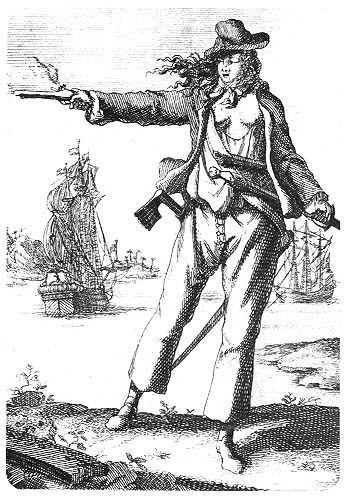
Wikimedia Commons
Anne Bonny (1698–1782) was an Irish pirate who operated in the Caribbean, one of only a few female pirates in the historical record. The little that is known of her life comes largely from Captain Charles Johnson’s A General Historie of the Robberies and Murders of the Most Notorious Pyrates, (1724).[a]The author Angus Konstam has suggested that Johnson may have been an alias used by the English playwright Charles Johnson, the British publisher Charles Rivington, or the writer Daniel Defoe.[1]
Anne joined up with the flamboyant pirate known as Calico Jack Rackham, and became his pirate partner and lover. She was captured alongside Rackham and her fellow female pirate Mary Read,[b]According to witnesses at their trial, Anne Bonny and Mary Read were the fiercest members of the pirate crew.[2] and all three were sentenced to death in 1721. But as she was pregnant with Rackham’s child, the sentence was never carried out and she was reprieved. Anne went on to become a respectable married woman, dying at the age of eighty-four in South Carolina.[2]
Early life
Anne was born near Cork, Ireland in 1698. Possibly the illegitimate daughter of the lawyer William Cormac and his maidservant, she was raised as a boy. But finding that his legal practice was affected by the child’s existence Cormac decided to leave Ireland, taking Anne and the maid with him. The family sailed to South Carolina, where he became a successful merchant and purchased a plantation.[2]
Anne appears to have had something of a temper as a young girl, allegedly killing a servant with a knife and beating an “over-amorous” suitor almost to death.[3]
Introduction to piracy
In 1718 Anne married James Bonny, a poor sailor and small-time pirate, which so upset her father that he disinherited her.[2][3] There is a story that Bonny set fire to her father’s plantation in retaliation, but there is no supporting evidence.[4] It is known however that Anne and her husband moved to the island of New Providence in the Bahamas, a sanctuary for English pirates known as the Republic of Pirates.[4] Following the arrival of Governor Woodes Rogers in the summer of 1718, James Bonny became an informer, supplying the governor with information about pirates in the area.[5]
Anne began frequenting the waterfront taverns of the Bahamas without her husband, sometimes dressed in men’s clothes. There she met and was courted by the pirate John Rackam (d. 1720), whose distinctive striped pants had earned him the nickname Calico Jack.[6] Anne’s husband may have attempted to sellWay of ending an unsatisfactory marriage by mutual agreement that probably began in the late 17th century, when divorce was a practical impossibility for all but the very wealthiest. her in a local tavern,[3] or alternatively Calico Jack might have offered him money if he would divorce her. But in any event she was persuaded to leave her husband and go to sea with Rackham. She disguised herself as a man on the ship, and only Rackham and fellow female pirate Mary Read were aware that she was a woman until it became clear that she was pregnant;[7] she was landed at Cuba, where she gave birth to a son. She then rejoined Rackham and continued her life as a pirate, having divorced her husband and married Rackham while at sea. Bonny, Rackham, and Read stole the ship William, then at anchor in Nassau harbor, and put out to sea.[8] Rackham and the two women recruited a new crew, and spent years in Jamaica and the surrounding area.[9] Anne took part in combat alongside the men, and was named in a “Wanted Pirates” circular issued by Governor Rogers, published in The Boston News-Letter.[5]
Capture and imprisonment
In November 1720 Rackham and his crew were attacked by a heavily armed sloop captained by the privateer Jonathan Barnet. Most of Rackham’s pirates put up little resistance, as many were too drunk to fight; only Anne, Mary and one other pirate out of their ship’s crew of ten attempted to resist Barnet’s men.[10] After being forced to surrender the crew was taken to Jamaica, where they were tried by an Admiralty court presided over by Sir Nicholas Lawes, governor of Jamaica. Rackham and all ten of the male members of his crew were convicted and sentenced to be hanged.[2] According to Johnson, Bonny’s last words to Rackham were: “Had you fought like a man, you need not have been hang’d like a dog”.[11]
Anne and Mary were also found guilty and sentenced to be hanged, but both “pleaded their bellies” – asking for mercy because they were pregnant – and were reprieved. Mary died in prison, most likely from a fever from childbirth, and was buried on 28 April 1721.[2]
Later life
There is some evidence to suggest that Anne’s father succeeded in having her released from prison and took her back to South Carolina, where she gave birth to Rackham’s second child. On 21 December 1721 she married a local man, Joseph Burleigh, with whom she had eight children. Anne died a respectable woman in South Carolina at the age of eighty-four, and was buried on 25 April 1782.[2]
Notes
| a | The author Angus Konstam has suggested that Johnson may have been an alias used by the English playwright Charles Johnson, the British publisher Charles Rivington, or the writer Daniel Defoe.[1] |
|---|---|
| b | According to witnesses at their trial, Anne Bonny and Mary Read were the fiercest members of the pirate crew.[2] |
References
Bibliography
This article may contain text from Wikipedia, released under the Creative Commons Attribution-ShareAlike License.
